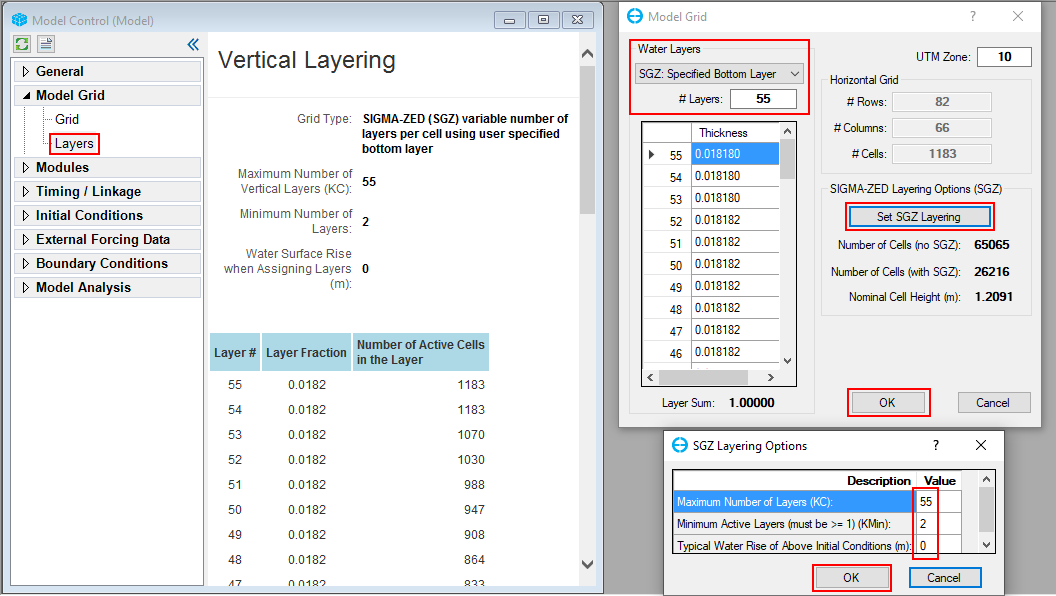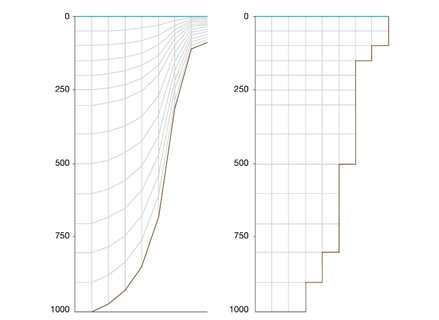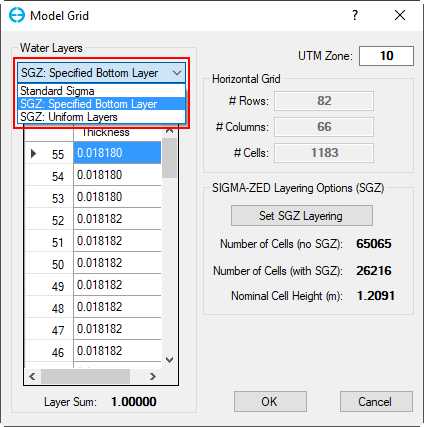The Layers sub-menu summarizes the vertical layering in the grid. RMC on this menu item provides the options by which the user may configure the vertical layering system as shown in Figure 1. Here the user can select the Sigma Zed (SGZ) vertical layering option which is implemented with EFDC+ alongside the previous option of Standard Sigma grid (SIG). In the Water Layers form the user and set the number of layers and access a drop-down menu option for the type of layering used in the model. These layering options are described in more detail below.
Figure 1. Model Grid menu: Layers
Standard Sigma Stretch Grid
The Standard Sigma option for water layers is the original EFDC option. When this is selected the SGZ options are not displayed.
The table in the Water Layers frame shows the primary water layer settings (KC = the number of water layers) and the distribution of the relative layer thicknesses.
The relative thicknesses must add up to 1 (or very close). EFDC+ Explorer checks this for the user. EFDC+ Explorer will automatically divide the water layers into equal fractions based on the number of layers specified by the user. Note that layer 1 is the bottom most layer and that the highest layer number is the surface layer (i.e. KC).
A very useful feature during preliminary testing of a model application is the rapid adjustment of layering simply by changing the number of layers. EFDC+ Explorer simply reallocates the layering based on the new KC and then adjusts all the boundary conditions to reflect this change. Use this feature with care, but it has been used on many applications and found to work well.
Sigma-Zed Vertical Layering
EFDC+ Explorer implements DSI's improved version of the EFDC code, the EFDC+_SGZ. DSI has developed this version to deal with pressure gradient errors that occur in models that have steep changes in bed elevation. This new version of the code is called the Sigma-Zed code, or EFDC_SGZ. This version contrasts with the conventional sigma stretch version (SIG) of the EFDC code in terms of vertical layering in the model. SIG uses a sigma coordinate transformation in the vertical direction and uses the same number of layers for all cells in the domain. To accommodate the varying depths over the model domain in the SIG approach, the thickness of the layers vary from cell to cell but the number of layers and fraction of depth for each layer are constant. SIG approach introduces a well-known error in the density gradient terms, otherwise known as the pressure gradient error (Mellor, et. al. 1994). These errors are most pronounced in regions with steeply varying bathymetry.
The new vertical layering approach (SGZ approach) developed and applied to the EFDC model is computationally efficient and significantly reduces pressure gradient errors. In the EFDC_SGZ model, the vertical layering scheme has been modified to allow for the number of layers to vary over the model domain. Each cell can use a different number of layers, though the number of layers for each cell is constant in time. As with the Sigma Stretch approach, the thickness of each layer varies in time to accommodate the time-varying depths. The z coordinate system varies for each cell face, matching the number of active layers to the adjacent cells. The new version is computationally more efficient than a similarly configured Sigma Stretch grid, thus making models with 20 to 50 layers or more practical for typical projects.
A comparison of SIG and SGZ grids is shown in Figure 2.
Figure 2. Vertical grids for Sigma stretch (left) and Sigma-Zed (right).
The model grid specification as SIG or SGZ can be made in the main form of EE from the Model Grid menu and RMC on Layers menu item which displays the form shown in Figure 3. The first option Standard Sigma is the conventional gridding scheme of EFDC model.
The two options for implementing SGZ option in EE are SGZ Specified Bottom Layer and SGZ Uniform Layer Thickness.
Specified Bottom Layer (GRIDV=1)
In Specified bottom layer, the layer thickness of the adjacent cells in the vertical does not align in the same plane. Maximum depth in the model is first calculated and the maximum layer thicknesses are determined based on maximum depth. Zonation can be applied using this option. This is the robust option and can be applied to any type of system such as stratified systems, and systems with rapidly changing bed elevation.
Uniform Layer Thickness (GRIDV=2)
The layer thickness of the cell is most of the same size as the neighboring cell. The bottom layer thickness can be from 20-120% of the overlying layer. The maximum thickness is first calculated throughout the domain. Thickness at each layer for the cell with maximum depth is then calculated by multiplying DZCK with maximum thickness. Zonation cannot be applied in Uniform Layers option. Uniform Layers is suitable in quiescent systems where there is very little external flow influence such as lakes without steep sloping sides.
When computing buoyancy integrals in the model, there are differences between layer thickness and the difference between elevation. Using the uniform layer thickness, the differences between layer thicknesses are very small except for the regions with minimum sigma layers.
The SIGMA ZED Layering Options form provides the user with the option of specifying the maximum and minimum layers to be used in the model. After selecting Set SGZ Layering and OK, the layers are all automatically updated to the Sigma Stretch layering.
Figure 3. Model Grid: Water layering options.
Sigma-Zed Specified Thickness from Top (GRIDV=3)
This option allows the user to specify layer thickness precisely and not just provide an approximate value for each layer. As a result, the user has control over the initial thicknesses. Further adjustments were applied to EEMS to manage isolated cells at the bottom layer. Cells that are disconnected from all other cells in all four directions exhibit instability. Consequently, EE will automatically eliminate these isolated cells and merge them with the cells above. The SGZ Option 3 can be an appropriate choice when modeling a gate-based construction. In addition, dividing layers by depth provides considerable flexibility when simulating hydraulic structures, as users can directly specify the desired depth to be set based on the project's parameters as well as the water level around the modeled area.


